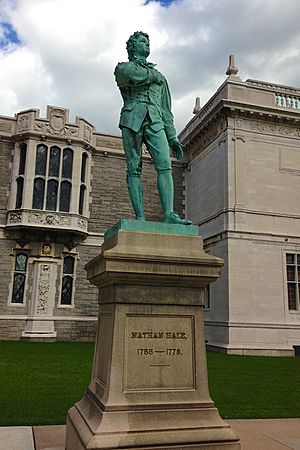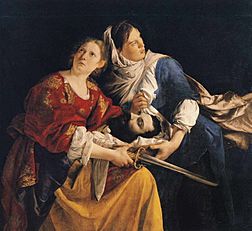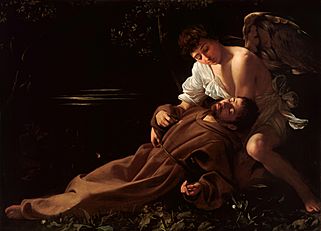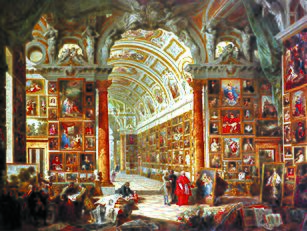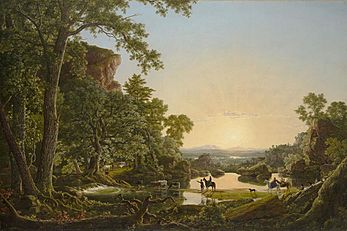Wadsworth Atheneum facts for kids
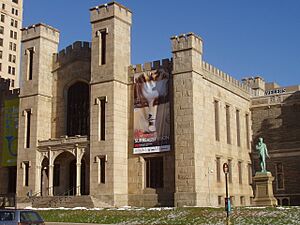 |
|
| Established | 1844 |
|---|---|
| Location | 600 Main Street, Hartford, Connecticut, U.S. |
| Type | Art museum |
| Public transit access | |
The Wadsworth Atheneum is a famous art museum located in Hartford, Connecticut. It's known for its amazing collections of art from different times and places. You can see European Baroque art, ancient Egyptian and Greek bronzes, and beautiful French and American Impressionist paintings. The museum also has Hudson River School landscapes, modern art, and old American furniture.
The Wadsworth Atheneum was started in 1842 and opened its doors in 1844. This makes it the oldest public art museum in the United States that has been open continuously.
The museum is at 600 Main Street in downtown Hartford. It looks like a cool castle! It's the biggest art museum in Connecticut, with lots of space to show off its art. The building was added to the National Register of Historic Places in 1970.
Contents
About the Wadsworth Atheneum
How the Museum Started
The Wadsworth Atheneum was built on land that belonged to the family of Daniel Wadsworth. It's right in the middle of downtown Hartford. The architects who designed the original "castle" building were Alexander Jackson Davis and Ithiel Town. Construction began in 1842, and the museum officially opened on July 31, 1844. It has been open ever since!
The Wadsworth family was one of the oldest and richest families in the city. They gave many valuable art pieces to the museum when it first opened. The first collection had 78 paintings, two marble busts, one small portrait, and one bronze sculpture.
Besides art, the first building also housed the beginnings of the Hartford Public Library and the Connecticut Historical Society. This is why it was named "Atheneum," which means a place for culture and learning. Because of this, the Wadsworth has always hosted many cultural events. These include plays, dance shows, history exhibits, and social gatherings.
How the Collections Grew
Over the years, many generous people have given art and money to the museum. Two very important donors were Elizabeth Jarvis Colt and John Pierpont Morgan. Elizabeth Jarvis Colt was the wife of the famous gun maker Samuel Colt. She gave over 1,000 objects, including many Hudson River School landscapes and the Colt firearms collection.
John Pierpont Morgan, a financier from Hartford, also gave more than 1,000 objects. These included valuable Renaissance decorative arts and old American furniture. Samuel P. Avery also donated many items, from ancient clay tablets to Chinese porcelain and French sculptures. He also gave money for new buildings. This led to the country's first museum interior designed in a modern style.
In 1927, the museum received a large gift of money from banker Frank Sumner. This money helped the museum buy many important artworks. With this fund, museum directors like A. Everett 'Chick' Austin and Charles Cunningham bought major works by famous artists. These artists include Caravaggio, Dalí, Gauguin, Miró, and Van Dyck.
In the 1940s and 1950s, more gifts added to the museum's collection of Hudson River School and Impressionist paintings. Famous pieces by Church, Cole, Gifford, Monet, and Renoir joined the collection. During this time, the museum also gained ancient Cypriot, Egyptian, and Greek items. Paintings by modern artists like Peter Blume and Stuart Davis were also added.
In 1973, artist Mierle Laderman Ukeles cleaned the museum steps as part of an art show.
More recently, gifts from Tony Smith and Susan Morse Hilles have added important modern and contemporary art. These include works by Josef Albers, Jackson Pollock, Barnett Newman, and Mark Rothko. With funds from other families and individuals, the museum has acquired pieces by Alexander Calder, Artemisia Gentileschi, Cindy Sherman, and Kara Walker. In 2004, a gift of 125 photographs added works by artists like On Kawara and Ed Ruscha.
In 2010, the museum started a big renovation project. This project updated all five of the museum's buildings. It added more refurbished gallery space and completely reinstalled the museum's permanent collections. The renovation was finished in 2015 and received praise from art critics.
Museum Buildings and Art
The museum building itself is made up of the original castle-like structure. Four more wings have been added over the years, in different architectural styles. The museum is home to about 50,000 objects. These include ancient Roman, Greek, and Egyptian bronzes. There are also paintings from the Renaissance, Baroque, and French and American Impressionist periods.
You can also see 18th-century German and French porcelains, Hudson River School landscapes, and early American clothing. The collections cover more than 5,000 years of world history.
Outside the "castle" building, there is a statue of Nathan Hale from 1899. It was made by Enoch S. Woods.
The Atheneum also owns the A. Everett Austin House. This house was once home to one of the museum's most famous directors. It is now open to the public as a museum.
Museum Firsts
The Wadsworth Atheneum has a long history of being "first" in many ways.
In 1933, the Wadsworth helped George Balanchine move to the United States from the Soviet Union. Balanchine later started the School of American Ballet, which led to the New York City Ballet. He chose the Wadsworth's Avery Memorial Theatre for the first performances of his School of American Ballet in December 1934. This included his first ballet choreographed in America, Serenade.
The museum was the first in America to buy art by Salvador Dalí, Balthus, Frederic Church, Michelangelo Merisi da Caravaggio, and Piet Mondrian. Under the direction of Arthur Everett Austin, Jr., the first American show of surrealism was held at the Wadsworth in 1931. The first major U.S. show of Pablo Picasso's work was held there in 1934. Also in 1934, the first performance of the opera Four Saints in Three Acts by Gertrude Stein and Virgil Thomson took place at the Atheneum.
-
Orazio Gentileschi, Judith and Her Maidservant with the Head of Holofernes, 1621-1624
-
St. Francis in Ecstasy by Caravaggio, c. 1595, oil on canvas, 92,5 x 128,4 cm, Wadsworth Atheneum, Hartford, Connecticut
-
Giovanni Paolo Pannini, Interior of a Picture Gallery with the Collection of Cardinal Silvio Valenti Gonzaga, 1740
-
Hooker and Company Journeying through the Wilderness from Plymouth to Hartford, in 1636, Frederic Edwin Church, 1846
-
Pierre-Auguste Renoir, Claude Monet Painting in His Garden at Argenteuil, 1873
-
The Lady of Shalott, William Holman Hunt, c. 1888-1905
See also
 In Spanish: Wadsworth Atheneum para niños
In Spanish: Wadsworth Atheneum para niños


